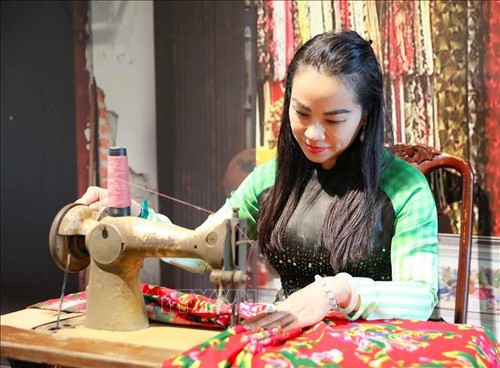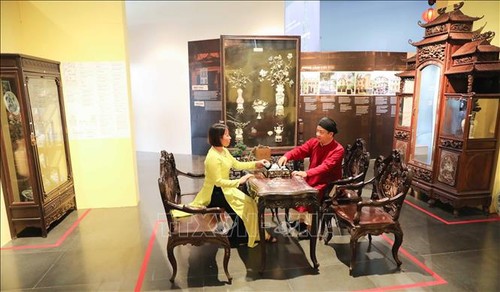 An antique sewing machine is on display at the exhibition. (Photo: VNA) An antique sewing machine is on display at the exhibition. (Photo: VNA) |
On display are 200 documents and artifacts, arranged in four categories – the village, the living room, the ancestral altar, and the traditional long dress.
In the first section of the exhibition, a replica of a village gate welcomes visitors. Beyond the village gate a winding “village road” leads to the other sections.
A typical living room is decorated with a horizontal lacquered board on which the word “Harmony” is engraved in Chinese characters, expressing the wish for a harmonious family life. Porcelain cups and plates and tables and chairs intricately carved with patterns of flowers and birds recall the lives of affluent urban families.
The ancestral altar, the most solemn space in a Vietnamese home, displays incense burners, antique vases, large wooden trays, and parallel sentences on horizontal lacquered boards.
The exhibition’s final section showcases Vietnam’s traditional long dresses called ao dai. A recreation of Hanoi’s once well-known Phuc Trach tailor’s shop is stocked with colorful ao dai, peacock feather pattern blankets, and antique sewing machines.
The exhibition reminds elderly visitors of their memories of Hanoi as it used to be and teaches younger visitors something about the lifestyle of their predecessors.
“The exhibition shows Hanoi in times past. This glimpse of the past allowed me to see how Hanoi has changed, and it encourages young Vietnamese to cherish their culture,” said Nguyen Thi Thuy Hang, a student at the Hanoi University of Culture.
 A corner of the “Nep xua” exhibition. (Photo: VNA) A corner of the “Nep xua” exhibition. (Photo: VNA) |
“I found the objects on display amazing and interesting, like the “four flap” ao dai, and the tables and chairs engraved with intricate patterns, which show how skillful artisans were in the past,” said Tran Minh Ngoc of Cau Giay district.
Ms. Nguyen Thi Ngoc Hoa, a Hanoi Museum official, said, “We have done a lot of research on traditional houses in Hanoi and collected many materials for this exhibition. The house furnishings reflect the culture and lifestyle of Hanoi’s inhabitants in the early 20th century.”
The exhibition will continue through the end of the year.